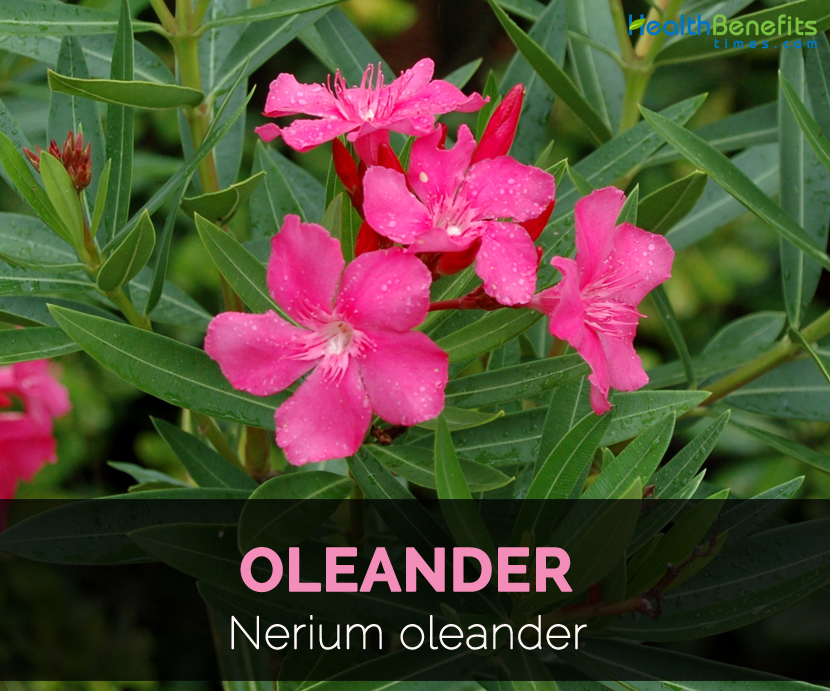| Oleander Quick Facts | |
|---|---|
| Name: | Oleander |
| Scientific Name: | Nerium oleander |
| Origin | Mediterranean region and is also found in Southern Europe and Southwest Asia |
| Shapes | Elongated, 3 to 6 inches long |
It ordinarily occurs around dry stream beds. The plant thrives in hot and mild climates and is tolerable to drought, high salt content in soil and poor drainage. Oleander is propagated by seed but as a highly heterozygous and allogamous, it has greater variability in seedling populations. Furthermore, the alluring flowers of this plant are a hazard for accidental ingestion. But the plant is used in homicides and folk medicines. All parts of the plant possess cardiac glycosides which includes roots.
Other common names for Oleander are Adelfa, Cascabela thevetia, Baladre, Common Oleander, Cerbera thevetia, Exile Tree, Jia Zhu Tao, Huang Hua Jia, Kaner, Karvir, Laurel Rosa, Karvira, Laurier-Rose, Laurier Rose, Nérier à Feuilles de Laurier, Laurose, Nérion, Nerium Oleander, Nerium indicum, Nerium odorum, Oleandre, Oleander blatter, Oleandri folium, Rose Laurel, Rose Bay, Sweet Scented Oleander, Thevetia peruviana, Thevetia neriifolia and Yellow Oleander.
Plant description
Oleander grows 12 feet high with erect stems splaying outward when mature. In the first year, stems are glaucous and when matured have grayish bark. Leaves form in pairs or whorls of three, usually leathery, thick, dark green, narrow lanceolate and measures 5 to 21 cm long and 1-3.5 cm (0.39-1.4 in) broad with entire margin. It resembles the leaves of olive and bay trees. Flowers bloom in clusters at the end of each branch usually in spring and summer. Flowers are white, pink to red about 2.5-5 cm (0.98-2 in) diameter and have five petals with deeply 5-lobed fringed corolla round the central corolla tube. It resembles a tiny rose. Flowers give way to a long and narrow capsule 3-6 inches long which splits open when matured in order to release diverse downy seeds.
Traditional uses
- The plant parts such as bark, flowers, leaf juice and latex leaves are used to treat microbial and fungal diseases.
- Leaves and bark acts as a heart tonic, expectorant, emetic, diuretic and diaphoretic.
- Boil the roots in water and use it for herpes, ringworm infection and skin complaints.
- Apply the leaves juice (in small dose) for snake and other venomous bites.
- Young leaves juice is used to cure eye diseases.
- Use the root paste for hemorrhoids, ulceration, cancer and leprosy.
- Oil extracted from root is used for skin diseases as well as leprosy.
- Apply the leaves decoction externally for treating scabies and lower swellings.
- It is used to cause abortion.
- Macerated leaves are used for hair loss, scabies, toothache, diabetes and lice in Morocco, Africa.
- Roots are used to form plaster and also applied to tumors.
- Use the root bark oil to scaly skin diseases.
- Leaves, flowers, latex or leaf juice, roots and bark are used as a treatment for warts, corns, hard tumors, carcinoma and cancerous ulcers.
- Apply the paste for alopecia.
- Use the powdered root with water to treat venereal diseases.
- Leaves powder is used for treating epilepsy.
- In India, people use twigs and thin branches of the plant as toothbrush. It strengthens loose teeth.
Medicinal applications
- Face pack
Apply the flowers paste on the face. It improves skin complexion and texture.
- Hemorrhoids
Roots paste is applied externally on hemorrhoids.
- Joint pain
Mix the leaves paste with oil and apply it to affected joints.
- Skin diseases
Boil the decoction of Oleander in mustard oil. Apply this oil to the affected areas of the body.
- Itching
Apply the medicated oil (prepared from Oleander leaves) externally.
- Ear pain
Boil the stem bark juice with gingelly oil. Put 2 drops of this oil to ear for treating ear pain.
- Scorpion sting, snake bite, ulcers, leprosy, skin diseases
Apply the roots paste externally.
- Swelling ulcers on penis
Use the leaves decoction to wash the affected areas.
- Venomous bite
Apply the leaves juice externally.
- Heart pain
Take 100 to 200 mg of root bark after meals. It causes heavy urination curing heart pain. It also cures other problems associated to heart.
- Headache
Crush Oleander flowers with Indian gooseberry in kanji (a fermented drink made with beets, carrots and mustard). Apply this paste on forehead for immediate relief.
- Piles
Apply the root paste to boils.
- Eczema
Use the root bark oil on affected areas. It is a cure for all types of eczema, dermatose and itching.
- Contagious diseases
Massage the leaves oil for any contagious/monsoonal diseases. It prevents the micro-organisms growth.
- Itching
Apply the oil prepared from Oleander leaves.
Precautions
- The entire plant consists of toxic cardiac glycosides. Roots and seeds contain more.
- The smoke from the plant and also the water in which plant is immersed is toxic.
- The symptoms for oleander toxicity: nausea, pain in oral cavity, abdominal pain, emesis, diarrhea and cramping.
- Any part when ingested causes vomiting, nausea, bloody diarrhea, irritation to mucosal membranes, increased salivation, burning around mouth, dizziness, confusion, weakness, drowsiness, cardiac abnormalities, visual disturbances, bradycardia, tachyarrhuthmias, ventricular dysrhuthmias and heart block.
- Intake of flowers is also harmful.
- Rash occurs with a skin contact with sap of oleander leaves.
- It is regarded to be toxic for consumption for humans as well as animals.
- Not recommended to use in lactation, pregnancy and in children.
References:
https://www.itis.gov/servlet/SingleRpt/SingleRpt?search_topic=TSN&search_value=30184#null
http://www.hear.org/pier/species/nerium_oleander.htm
https://botanical.com/botanical/mgmh/o/oleand04.html
http://hort.ufl.edu/database/documents/pdf/tree_fact_sheets/nerolea.pdf
http://www.tropicalplantresearch.com/archives/2016/vol3issue2/23.pdf
http://impactfactor.org/PDF/IJPPR/6/IJPPR,Vol6,Issue3,Article31.pdf
https://www.bimbima.com/ayurveda/oleander-nerium-indicum-information-uses-and-warnings/200/
https://www.theayurveda.org/ayurveda/herbs/10-health-benefits-of-oleander-flower
https://www.diethealthclub.com/dietary-supplements/oleander.html
Comments
comments
